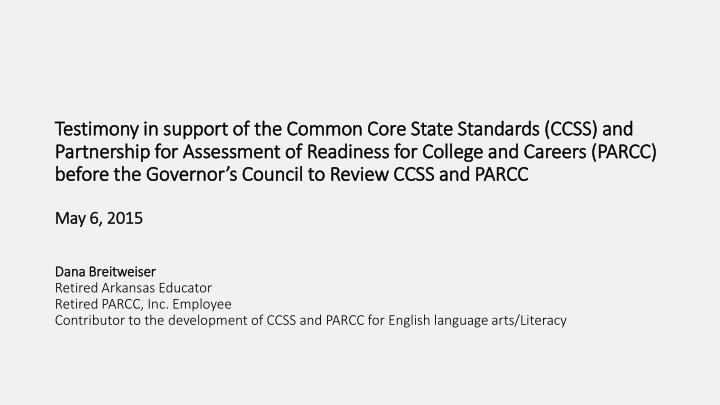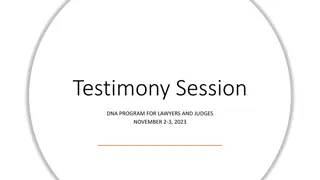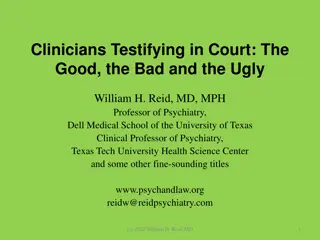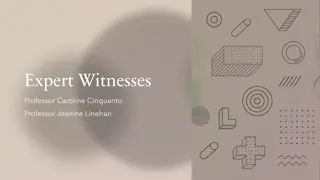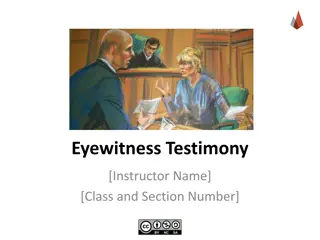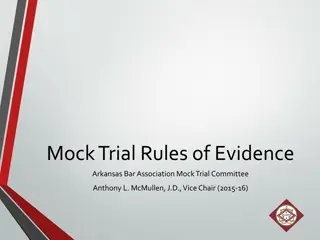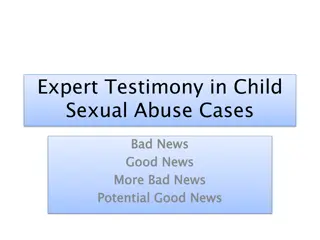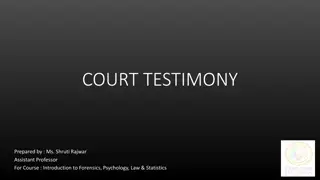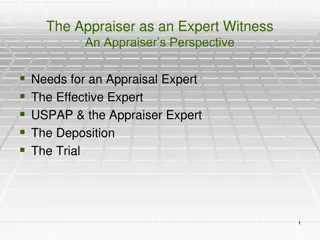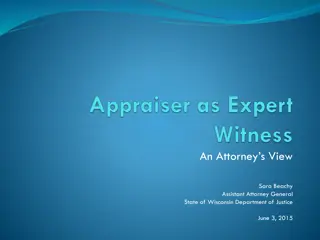Testimony in Support of Common Core State Standards and PARCC
Dana Breitweiser, a retired Arkansas educator and contributor to the development of CCSS and PARCC, presented testimony in support of the standards before the Governor's Council. The process of writing the standards involved a comprehensive committee and feedback mechanisms. The validation committee found the standards to be reflective of necessary core knowledge and skills for college and career readiness. These standards are considered a solid foundation for cross-state adoption and future assessments, respecting the authority of individual states to govern their education systems.
Download Presentation

Please find below an Image/Link to download the presentation.
The content on the website is provided AS IS for your information and personal use only. It may not be sold, licensed, or shared on other websites without obtaining consent from the author.If you encounter any issues during the download, it is possible that the publisher has removed the file from their server.
You are allowed to download the files provided on this website for personal or commercial use, subject to the condition that they are used lawfully. All files are the property of their respective owners.
The content on the website is provided AS IS for your information and personal use only. It may not be sold, licensed, or shared on other websites without obtaining consent from the author.
E N D
Presentation Transcript
Testimony in support of the Common Core State Standards (CCSS) and Testimony in support of the Common Core State Standards (CCSS) and Partnership for Assessment of Readiness for College and Careers (PARCC) Partnership for Assessment of Readiness for College and Careers (PARCC) before the Governor s Council to Review CCSS and PARCC before the Governor s Council to Review CCSS and PARCC May 6, 2015 May 6, 2015 Dana Breitweiser Dana Breitweiser Retired Arkansas Educator Retired PARCC, Inc. Employee Contributor to the development of CCSS and PARCC for English language arts/Literacy
The Standards Writing Process The Standards Writing Process Standards Writing Process AR Frameworks CCSS Committee comprised of 50-60 members X X Committee includes K-12 and post-secondary educators X X Review most current research X X Review standards from other states and countries X X Write initial draft of standards X X Revise multiple drafts of standards X X Period of public feedback and revision X (begun 2015) X Validate standards X Adopt standards X X Implement standards* X X Written over 2 weeks in summer and 4-5 days in fall, as needed X Written over 14 months (May 2009 June 2010) X *Standards are not piloted or tested before implementation.
Findings of the CCSS Validation Committee Findings of the CCSS Validation Committee Reflective of the core knowledge and skills in ELA and mathematics that students need to be college- and career-ready Appropriate in terms of their level of clarity and specificity Comparable to the expectations of other leading nations Informed by available research or evidence The result of processes that reflect best practices for standards development A solid starting point for adoption of cross-state common core standards A sound basis for eventual development of standards-based assessments Reaching Higher: The Common Core State Standards Validation Committee. A report from the National Governors Association Center for best practices & the Council of Chief State School Officers, June 2010. http://www.corestandards.org/assets/CommonCoreReport_6.10.pdf
Conclusion of the Validation Committee Conclusion of the Validation Committee These certified research- and evidenced-based standards aligned with college and career expectations respect unique state contexts and the authority of each state to govern its public education system. The lasting hallmark of this process on student achievement, then will be clear, easy, and straightforward comparability over time standard by standard, assessment by assessment, and state by state. These common standards are an important step in bringing about a real and meaningful transformation of the education system for the benefit of all students. Reaching Higher: The Common Core State Standards Validation Committee. A report from the National Governors Association Center for best practices & the Council of Chief State School Officers, June 2010. http://www.corestandards.org/assets/CommonCoreReport_6.10.pdf
Developmental Appropriateness of the Developmental Appropriateness of the ELA/Literacy and Math CCSS Standards ELA/Literacy and Math CCSS Standards We believe that taken as a whole, the draft standards were fair and age appropriate for kindergarten through 3rdgrade. Source: April 15, 2010 Summary of the March 10 CCSS draft standards Joint Statement of the National Association for the Education of Young Children and the National Association of Early Childhood Specialists in State Departments of Education on the Common Core Standards Initiative Related to Kindergarten through Third Grade http://www.naeyc.org/files/naeyc/file/policy/NAEYC-NAECS-SDE-Core-Standards-Statement.pdf
Developmental Appropriateness of the Developmental Appropriateness of the ELA/Literacy and Math CCSS Standards ELA/Literacy and Math CCSS Standards Because DAP can robustly incorporate learning standards in the years before kindergarten, teachers should be able to so in the early elementary years (K-3) through the Common Core. (p 3) Source: National Association for the Education of Young Children (NAEYC). 2015. Developmentally Appropriate Practice and the Common Core State Standards: Framing the Issues. Research brief. Washington, C: NAEYC. https://www.naeyc.org/files/naeyc/15_Developmentally%20Appropriate%20Practice%20and%20th e%20Common%20Core%20State%20Standards.pdf
ELA/Literacy Design: Reading literary and ELA/Literacy Design: Reading literary and informational texts to build knowledge informational texts to build knowledge Key Ideas and Details 2: Determine central ideas or themes and analyze development; summarize 3: Analyze development and interaction of individuals, events, and ideas Craft and Structure 4: Interpret words and phrases; how word choice shapes tone 5: Relationships among sentences, paragraphs, and larger portions of text, and the whole text 6: How point of view or purpose shapes content or style Integration of Knowledge and Ideas 7: Integrate/evaluate content in diverse media and formats 8: Evaluate the argument and claims in a text 9: Analysis across texts that address similar themes or topics 1 Evidence to support conclusions drawn from texts _____ 10 Range of complex texts
ELA/Literacy Design: Writing effectively to communicate ELA/Literacy Design: Writing effectively to communicate understandings gained from reading texts understandings gained from reading texts Production and Distribution of Writing 4: Development, organization, and style appropriate to task, purpose, and audience (incorporates language standards to write clearly and coherently) 5: Strengthen writing through revision process 6: Use technology to produce and publish writing Research to Build and Present Knowledge 7: Short as well as sustained research projects 8: Integrate relevant, credible, and accurate information from multiple print and digital sources 9: Support analysis, reflection, and research with textual evidence Range of Writing 10: Write routinely for a range of tasks, purposes, and audiences Text Types and Purposes 1 Argument _____ 2 Informative/ Explanatory _____ 3 Narrative
Factors That Make the CCSS High Factors That Make the CCSS High- -Quality Standards Standards Quality Factors to Consider CCSS Writing process reflects accepted practice Knowledge and skills are developmentally and age appropriate Standards are clear and specific Standards are informed by research and evidence Design and structure support integrated approach to teaching and learning Standards support a strong, vertically- and horizontally-aligned curriculum Emerging evidence Longitudinal data indicate positive impact on student learning Emerging evidence
Assessing the Letter and the Spirit of the CCSS Assessing the Letter and the Spirit of the CCSS Build an Arkansas assessment. Collaborate with other states to build an assessment. Shared burden of cost and human resources to develop and implement online assessment. Cost of developing and implementing an online assessment. Access to more supporting resources. Limited human resources for test development and creation of supporting resources.
Assessment Choices Assessment Choices Computer Fixed Form, Criterion-Referenced Assessment Aligned to the CCSS Created by states PARCC* Computer Adapted Criterion-Referenced Assessment Aligned to the CCSS Created by states SBAC Computer Fixed Form Criterion-Referenced Assessment Not aligned to the CCSS; aligned to ACT standards Not created by states; created by ACT ACT Aspire *PARCC is the only CCSS assessment in which Arkansas educators have had a voice.
Achieving Alignment: Achieving Alignment: CCSS Prompt Changes in Assessment Design CCSS Prompt Changes in Assessment Design Assessing Previous ELA/Literacy Standards Assessing the CCSS ELA/Literacy Standards Paper/pencil Online What questions How and why questions No textual evidence required Textual evidence required Questions about a single text Questions about multiple texts All printed texts Texts include print and digital media More knowledge-level questions More critical thinking tasks Stand-alone writing prompts (if any) Writing prompts tied to reading multiple texts Big Shifts in Summative Assessment!
PARCC Achieves Alignment through PARCC Achieves Alignment through Evidence Evidence- -Based Design Based Design PARCC Summative Assessment makes claims about what students should know and be able to do at each grade level CCSS make claims about what students should know and be able to do at each grade level Evidences of student learning align with the CCSS Classroom Learning Activities Assessment Tasks
PARCC: Created by Arkansas Educators PARCC: Created by Arkansas Educators for Arkansas Students for Arkansas Students Arkansas Participates in All Decision-making Groups Governing Board ADE Commissioner State Leads ADE Assessment Director Operational Working Groups ADE Specialists Passage Review Committee AR Educators and ADE Specialists Item Review Committee AR Educators and ADE Specialists Bias Review Committee AR Educators and ADE Specialists Data Review Committee AR Educators and ADE Specialists Test Construction Committee AR Educators and ADE Specialists Forms Review Committee ADE Specialists Rangefinding Committee AR Educators and ADE Specialists Rangefinder Committee AR Educators and ADE Specialists Training Set Review Committee AR Educators and ADE Specialists See also: Testimony before Senate Education Committee
False PARCC Claims False PARCC Claims The federal government will receive personally identifiable student information. PARCC has a built-in 30% fail rate. FALSE PARCC Statement: States retain responsibility for and control over their data. Neither PARCC nor PARCC contractors will share student data with any outside entity, including the federal government. http://parcconline.org/data-privacy- security FALSE No PARCC blueprint or guidance document states that PARCC has a 30% fail rate. On criterion-referenced tests, including PARCC, students achieve levels of proficiency as guided by Performance Level Descriptors PARCC College- and Career-Ready Determination Policy and Policy-Level PLD s http://parcconline.org/ccr PARCC Grade- and Subject-level PLD s http://parcconline.org/plds Read: PARCCData Privacy and Security Policy http://www.parcconline.org/sites/parcc/f iles/PARCC%20Privacy%20Security%20Pol icy_Adopted%20by%20GB_12-05-13.pdf
Factors That Make PARCC Factors That Make PARCC a High a High- -Quality Assessment Quality Assessment Factors to Consider PARCC Uses accepted practice for building a new assessment Test design supports tight alignment to the standards it assesses Tasks reflect the type of learning implicated by the standards Passages and items reviewed for potential bias Online Accessibility Features and Accommodations for special populations State education leaders make policy-level decisions State educators are decision makers on all content committees Student- and district-level reports provide data useful for students, parents, teachers
